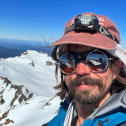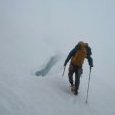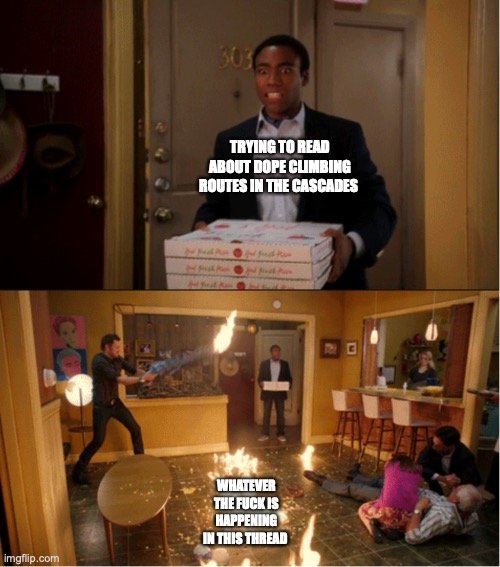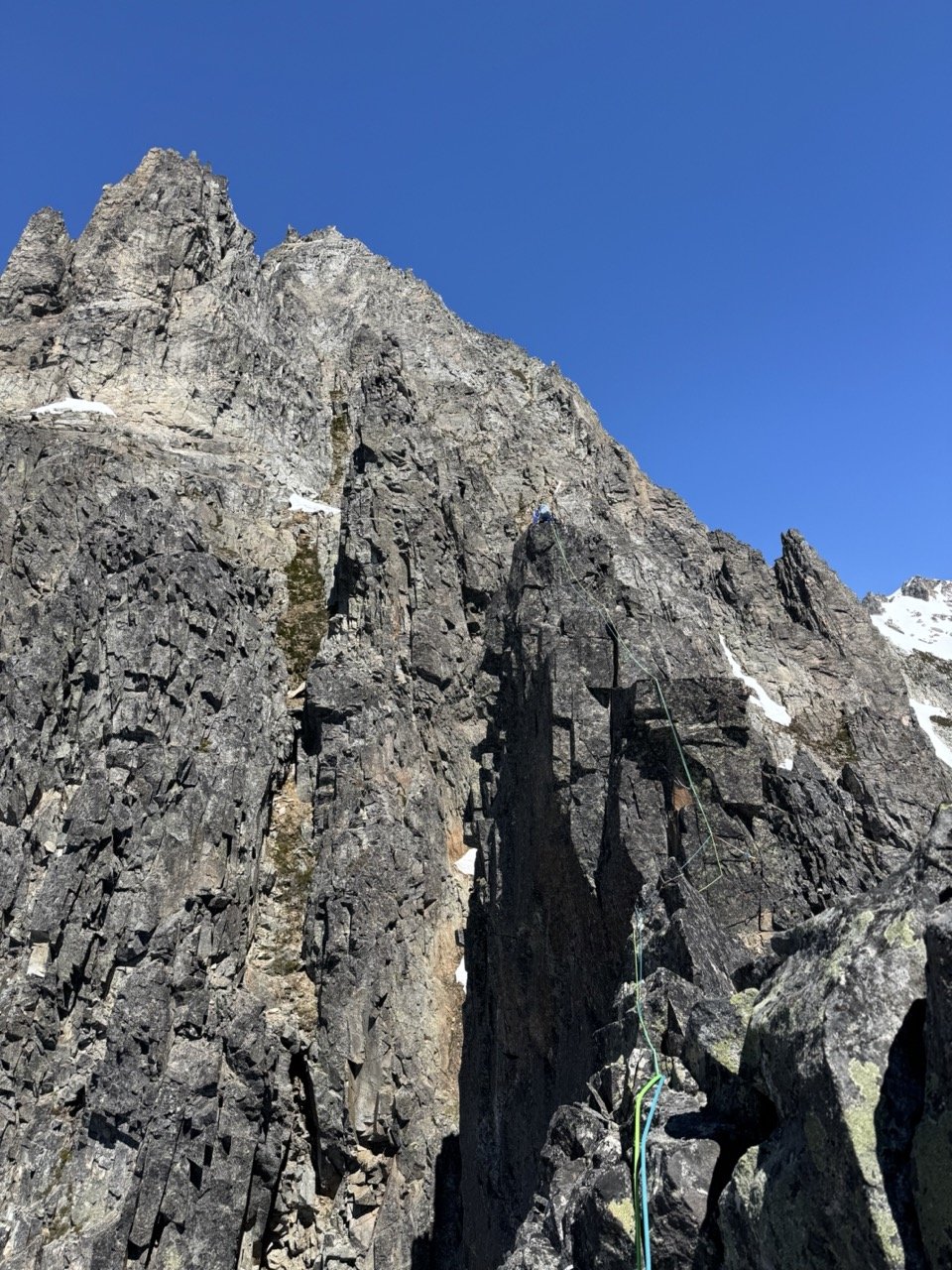-
Posts
26 -
Joined
-
Last visited
-
Days Won
9
emilio taiveaho pelaez last won the day on July 15
emilio taiveaho pelaez had the most liked content!
Recent Profile Visitors
The recent visitors block is disabled and is not being shown to other users.
emilio taiveaho pelaez's Achievements
-

Climbing Soundscape
emilio taiveaho pelaez replied to Balandino Di Donato's topic in Climber's Board
Fred Padula's 1978 film El Capitan has really great sound design that might be fruitful for your research. It's a film of remarkable beauty that doesn't subsume the climbing within a voice-over, and the sounds of pitons getting hammered give the ascent the feeling of a steely gamelan orchestra--the soundscape of the film is as important as the visuals. -

[TR] Despair (south peak) - East / SE side 09/12/2025
emilio taiveaho pelaez replied to JonParker's topic in North Cascades
Inspiring photos and report like always, thanks for sharing! What a surreal gorgeous place. -

Stolen/missing summit registers.....
emilio taiveaho pelaez replied to JasonG's topic in Climber's Board
The disappearing canisters are definitely a shame - for me they've always been part of the unforgettable collective experience of summits, as there is something undeniably awesome about seeing the names of the hardwomen/men who've shared the view & travails logged in those brass containers. This year I noticed canister on Whatcom was gone, but I know there used to be one there as I'd signed it in 2018. Since we're sharing pictures, here's a unique register from the Pickets, haha!: -
emilio taiveaho pelaez started following John_Roper
-
Reading Mike Layton's TR for "Plan 9" on the Blob (such a humbling read!!) suggests that the name comes from the 1958 sci-fi flick, which doesn't seem disrespectful as it's a classic in the horror genre. Plus, I've found something carnivorous and alien about the rock in the Pickets, haha! That N. Buttress on the Rake sure is gorgeous... I, too, hope to find out more about it, so really appreciate you starting this thread!
-

[TR] Eldorado Peak - West Arete 7/26/2025
emilio taiveaho pelaez replied to Nick Sweeney's topic in North Cascades
Awesome job on the climb and the write-up, that was a treat to read. -
Trip: Spectre Peak - Spirited Away (IV, 5.9, ~2000 ft, 10 pitches) Trip Date: 07/07/2025 Trip Report: "Spirited Away" Second Ascent Spectre Peak & Exploring the North-Western Pickets Adam "Mo" Moline & emilio Taiveaho Peláez Itinerary: Day 1: Camp on Easy Ridge Day 2: Perfect Pass & Whatcom Day 3: Perfect Pass to Phantom Ridge Day 4: Climb “Spirited Away” (2000’, IV, 5.9) on Spectre Peak Day 5: Push Camp to Copper Creek Day 6: Hike out from Copper Creek First is a pitch-by-pitch description of the climb, written by Mo, followed a trip report written by both of us in collaboration. We climbed ten pitches, including a long (~600 ft.) simul of 3rd-low 5th to the summit block. Several of our pitches (p.4-6) diverged from the first ascent route. The Climb: “Spirited Away” (FA: Sam Boyce, Joe Manning) is an excellent remote alpine climb with stunning features in a hauntingly beautiful landscape. Pitch 1. From the notch, Emilio leads right and up 4th class ramps to a chimney, then opts for going right to the 5.7 face with good high feet moving up to the tree ledge. ~35-40 meters. Pitch 2. Emilio finishes tower 1 by first scoping the 5.9 chossy overhang, then opting to shoot left for the clean Gully. We both wanted to add to Sam and Joe’s incredible line by exploring places they mentioned, and we’re happy to report the gully was a very enjoyable and clean 5.6 romp up Tower 1. Pitch 3. (Mo) I, who haven’t yet realized we’ve bypassed SJ’s crux, eagerly take the lead after moving the rope further along the large ledge. The long pitch starts with moving the rope along the large ledge and travels up the 3rd-4th class ridge with nothing close to a 5.9 chossy overhang, odd. Very enjoyable climbing though! At this point, I stay along the ridge crest completely enchanted by the tower and therefore diverge from Sam and Joe’s (SJ) line for the first time. I anchor in at the base of the obvious and impressive Tower 2. Pitch 4. Emilio leads up the tricky face with bad pro. They shoot for the corner to find good gear for the steep headwall. The options from below appeared to be a steep and potentially overhanging crack up the middle, or heading to a notch on climber’s left between the 2 spires into overhanging face climbing. Emilio picks an inspiring line up to the notch through the corner followed by 20-30 feet on the steep but surprisingly juggy face, 5.8. Pitch 4.5. After the tower and an awkward belay, Emilio lowers down 15 feet climber’s left off a slung horn to a ledge below to set up an anchor for the “sky bouldering” pitch. Mo down-leads easy but chossy terrain. Pitch 5. (Mo) Along with the tower, this divergence (??) is also a complete treat. Comparable to the Rooster Comb on Mongo, or climbing in the Fisher Towers, the sky bouldering pitch involved some of our favorite climbing. Along with a series of easy V0- boulders, the ridge presents a perfect hand crack splitting an impressive boulder. Climb up and over this 4 star boulder, gymnastically flow through more boulders digging your hands into serious lichen, and finish with a reachy smear onto extremely licheny rock suspended over air. Belay on one of the golden slabs below the next gendarme. Like the RC, it’s hard to put a grade on this type of gymnastic climbing, top shelf fun though. Pitch 6. Emilio climbs the corner block with good pro, up and left of the gendarme until they meet SJ’s line once again. After lowering off nut/horn pro left by the FA team, Emilio sets up an anchor out of the shooting gallery and I lower down to the very redundant anchor deep in the gully. The only pink tricam placement of the trip. The kind gear left behind by the FA party for this pitch. Pitch 7. (Mo) Lead up 4th class to a left trending ramp where 5-moderate begins. Future climbers take the larger, earlier ramp rather than be entranced by the huge bulgy crack splitting the face (like I did). After returning to the ramp, it meets the beautiful hands/fist crack. With many alpine draws, continue up to meet the slightly overhanging crux of the pitch with a mix of choss and bomber jugs. Physical wandering with cautious choss dancing leads right, up, then left through stellar holds to a clean finish. Steep and committing but surprisingly good holds made this feel like 5.8+. Good pro. Let the choss sleep here for the sake of your follower! Looking down from above the hand/fist crack. Pitch 8. Emilio climbs up the heather ramp with choss for roughly 30m but not great pro until the blocks. Follow 5-moderate blocks up and left. After running low on rope and scoping options, Emilio belays on choss 20ft below the ridge crest. Looking up at the heather ramp. Pitch 8 Notes: Continuing on the ridge crest could be an alternative to the heather ramp. To avoid rope drag on the Hoodoo pitch, belay from the ridge crest if possible. Pitch 9. (Mo) Hoodoos. 3 options presented themselves to reach the ridge crest. Follow Emilio’s wisdom and take the chimney to the right or the easy ramp to the left, or my idea to shoot straight up the white 5.9 face. With my hopeless delusion being prevention of rope drag, I shot up a few cruxy moves and pulled it without showering Emilio with choss. All of a sudden, the spirits are all around you. We traversed low around many of the hoodoos both out of a fearful respect of their haunting beauty and temporary nature. We didn’t stop for any pictures and quietly danced around their north sides when possible, or climbed over when it wasn’t. After this steep, exposed, licheny, and hauntingly beautiful traverse, rappel off the furthest Hoodoo for 25-30m to a nice grassy ledge, then move to avoid rockfall. Pitch 10. (Simul, Emilio then Mo). 600ft of 2nd, then 4th, then 3rd class stellar scrambling following heather ramps and solid rock. Emilio leads what was some of our favorite climbing of the ridge moving efficiently up to the headwall. Emilio hands me the kindest gift of finishing up the 5.0 pitch. We finish this climb in memory of Teemo (Chad) the Cat who was spirited away weeks before this climb. An inspiration of our climbing, style, and backcountry meals (Chad’s Backcountry Catfood), and who lived with Emilio and me over a decade ago. With Love, for Teemo. Climb Descent: We now realize Emilio has accidentally stached their ice axe at the base of the climb. However, before we tackle this challenge, we must figure out how to down climb the east side which appears ledgy at first, but then becomes 5.moderate and steep. We navigate and beta share our way down after some interesting 5th-class moves on good holds. This side of the rock was significantly harder climbing than the side we summited. Now, the fun begins. We read SJ’s report of steep snow and early conditions and see this to be true. However, we have luckily navigated somewhat similar situations where on Mongo Emilio traverses steep snow with sharp and flat rocks for aid. I (Mo) kick some deep steps down a short steep section in similar style. After a few minutes of thoughtful snow travel, it eases up to walking a beautiful snow ramp down to a heather and slab rib. From here, a gorgeous dyke ‘Thank God Ledge’ becomes obvious and points you directly home to the base of the climb. Walk the 2nd class dyke admiring the unique rock and granite eggs. This section feels like walking towards Minas Tirith. Follow until the dyke turns into heather ledges/ramps at the base of the climb. 10/10 descent, would maybe rap in the future, or find the actual route down. Ascent ~11hrs Descent ~1 hr Trip Report Introduction (written by emilio): “When you get to the top of the mountain, keep climbing.” Nothing embodies this mantra more than a trip to the Northern Pickets, with its endless folds, valleys, and ridges. Summertime in the northern hemisphere means it’s high time for licheny choss and remote alpine meadows. For me, the solstice brings a yearning for good snowpack and godly glaciers, and despite my attempts to think or dream of other mountains, climbs, and ranges, the Pickets keep calling me. Throughout the year, I often wake up in the middle of the night longing for their surreal gendarmes, gnarly towers, towering spires, and self-willed wildness. Last summer, Mo and I climbed the climb we’ll never come back from, Mongo Ridge on West Fury. The three nights we spent on route mark some of the most significant moments of my time here on Planet Earth, so it was difficult to tell what would unfold after that experience. But, as it often does with these things, the idea of returning to the Northern Pickets for a seventh time as a team came organically. This is a blessing, because nothing is better than going into the mountains with Mo, the strongest free-climber I know and one of the very best all-around humans I’ve ever met. Although for the last few years we’ve been entering the park through Ross Lake, the first time Mo and I went into the mountains together we went in through Hannegan Pass, embarking on the long trek up Easy Ridge with a group of six. That year, we ate hearty servings of humble pie as we crossed the Challenger Glacier, climbed Challenger, dropped down to Luna Cirque, hiked up the other side, and tumbled down Access Creek. Photo I took on a disposable camera on our first trip to Challenger (2018). This was the first any of us had roped up together, the day after Mo's first rap ever. Jake Johnson, secret hero of all our trip reports, leads the way. Returning to Hannegan Pass in order to visit those places of intensity where our love for the Pickets began—the Imperfect Impasse, Perfect Pass, Whatcom Peak (where I was first benighted), and the Challenger Glacier—with all these years of hard-earned experience felt right. Also, filling in the lore of Mongo, we knew that Wayne had first seen that mythic ridge while climbing the mind-boggling “Haunted Wall” of Spectre Peak. We had to at least see the Haunted Wall in person, to trace Mongo backwards, and get to know this obscure and remote peak we had seen from the neighboring ridge. The call from Spectre was coming from several directions. Beyond the opportunity to climb exquisite choss, the pleasure of going to such a remote country and live, even if momentarily, in the freedom of the hills, is hard to pass up. As a team, Mo and I have been on a little tour of second ascents across Washington (summiting Lemolo, “Sharpen the Saw,” and going up the Rooster Comb), often setting SKT’s in the process (slowest known time), so even if we didn’t yet have the gumption or cojones to repeat Mike Layton and Wayne Wallace’s insane line, we figured we could celebrate Sam Boyce’s remarkable achievement, “Spirited Away,” the South Ridge of Spectre, and enjoy our time in the process. The hoodoos, gymnastic traverses, and time spent on the ridge, made this line appealing. At the same time, Sam’s recent climbs in the Pickets have been inspiring to follow, and the beta he and Lani provided from their climb of Mongo made our experience on that ridge much more pleasurable, so our ascent of Spectre is a celebration of this current Picket Renaissance. As opposed to the ultra-light mentality we brought to Mongo, for Spectre we shouldered heavy packs, bringing extra food, creature comforts, and redundancy (including an additional pack stuffed inside my pack, which strangely came in handy) for the ~50 mile round trip and ~20,000 ft of elevation gain. We started our trip on the Fourth of July and budgeted the entire week ahead in order to adapt to the weather and be able to luxuriate like sybaritic alpine lizards. Trip Report (written in collaboration by both of us): Approach (days 1-3): We left the Moline Compound in Olympia early in the morning, driving steady to the Hannegan Pass trailhead to get there and get walking by 8:30 a.m. Surefoot miles brought us past hikers and trail crews hard at work. Crossing the Chilliwack was a treat in the heat and we zig-zagged the long diagonals up to Easy Ridge, encountering Chaga, old COTW, and copious Calf’s brain while admiring a solitary hand-crack along the way. For the return, we knew we’d have fresh berries Bilberries and Huckleberries. Like everything in the Cascades it seems like Easy Ridge is sandbagged because it’s a serious hike, but it also lives up to its name in the views it affords–though on our way up it was mostly clouds. We camped at a nice bivy before Easy Peak proper and drink some fresh Chaga tea. We stop after 15 miles and 7 hours of moving. The following morning we slept in and made coffee in the morning, taking our time before getting moving. Right as we pack up to take off, Mo’s side backpack zipper breaks exposing all the innards. After several seconds of perseverative thought, the universe reminded us that we have, in fact, 3 total backpacks between us! Not being able to decide which pack to climb in, Emilio serendipitously packed double bag includes both a 35L pack with a 30L pack stuffed inside. Mo’s pack is strapped shut with some climbing equipment (reminiscent of the broken crampons on Mongo attempt 1) and we ramble scramble onward without any anxiety of gear for the climb ahead. The scree-step up to the summit of Easy Peak brought us to more walking and descending, before reaching the threshold that the Imperfect Impasse provides. What a chasm! It’s hard to believe Mo’s first rappel ever was into the snow down below, though there was no need to rap today. Fourth class ramps and early season conditions were in our favor and we were able to quickly move across and head up the slab and heather to Perfect Pass. It’s nice to imagine what evaporating dew must feel as it ascends, but gravity in a human form is more easily navigated in diagonals. On the way up we ran into a group who had just summited Challenger, having camped at the bottom of the Impasse, but they were the only group we saw and from there we had Perfect Pass to ourselves. Given our odd timing at PP, to warm up for Spectre, and because it seemed ridiculously fun, we decided to drop our stuff and romp up Whatcom. The snow conditions were great and the sun was shining. Whatcom is a stunning mass and a wonderful teacher, and as specks on her summit we lingered admiring the landscape. The way back down to Perfect Pass brought joyful plunging leaping running down the mountain and we made twelve minutes of it, even after stopping to take pictures and laugh. Deciding Perfect Pass lives up to its name we made camp and stopped here for the night sleeping once again under chossy stars. emilio bouldering at perfect camp trying to strengthen the toes after descending from Whatcom. There are some quality blocs to be found out here! I’m wondering if FKT.com will allow for the Pass-to-Pass FKT to be submitted up to Whatcom, here we humbly submit 1 hour for our time. The next morning brought us to search for the somewhat mysterious Challenger Col. It’s mysterious because there are several possibilities for which one it may be and we had been overconfident on the beta for this section of the climb. After weighing our options we decided to go up high to the (later identified) West/Middle Challenger col and found some vintage tat. A slung horn of rope fibers suggested the way down a dihedral next to a stunning arete, and the glacier below seemed to provide ample access to the Western slopes of the Northern Pickets. We slung the same horn with fresh webbing and went down for a 35 meter rap. On the way down we found an offset nut with some red tat. The full rap was a little longer than 35 meters, but luckily it ended in a hungry offwidth so we were able to untie and downclimb a few extra feet to the snow, which provided a welcome ramp into the glacier. Here, again, we benefited from early season conditions. We navigated the glacier down to the south ridge of Phantom where we made a gorgeous rockside camp on clean slab near drippy snow. Sleeping early brought thought-dreams of the climb ahead and brief periods of waking up (at 8 pm) to gape at the Haunted Wall. Seeing the Great Gendarme that adorns the South Face and thinking about the bold, committing, and cerebral nature required to climb such an audacious route left us floored. For what it’s worth it’s worth remarking that Wayne Wallace and Mike Layton’s climb of the Haunted Wall of Spectre is perhaps one of the most impressive feats not just in Cascade climbing, but in USAmerican climbing more broadly. Mo enjoying an ice bath on Phantom Ridge preparing for the climb ahead. Harvesting Water on Phantom ridge. In lieu of prayer flags we adorned our camp with the tat we had found along the way. Mo with Mongo. Day 4 (climb): An alpine start at 3:40 has us moving to arrive at the climb with the sunrise. [See Previous pitch by pitch section] Descent (days 5-6): An alpine start at 4:00 a.m. has us moving well before daylight, as we hope to cross the Chilliwack by the end of the day in order to avoid the incoming weather. Cold coffee gets us moving and we go back up and down the rhyming patterns of scree, talus, and heather, scree, talus, and heather, until we hit the snow. We had debated whether we would try to find the actual “Challenger Col” that ostensibly did not require a rap to go down, or retrace our steps and retravel our known road up the glacier, and lead the pitch back up to the Col. The thought of leading the pitch back to the col had Mo full of energy so the decision to retrace our steps up to Solar Glacier was an easy one to make. Snow brought us back to the rock where Mo put on the rock shoes and racked up (only to place minimal gear). The arete provided excellent, though not well protected, 5.4 / 5.5 climbing. What an incredible way to get back on the Challenger Glacier! Back on the glacier we stayed high to scope out additional low points on the glacier. A stacked cairn gave indication that we had perhaps found Challenger Col. After reading several other trip reports, it’s hard to say which col is indeed the standard col to access the western side of the Pickets, but perhaps someone can help us piece this together. Looking up at the arete from the solar glacier & Mo leading the way. The rest of the day brought long miles up and down, through scree and talus and snow and heather, next to waterfalls and tarns, zig zagging under the sun. The snow on the imperfect impasse had melted so the way back was far spicier than the entrance. Thoughtful moving on steep terrain brought us back to the other side, having once again crossed that threshold into the Pickets. The moving kept going all day, as going down is often more of a climb than going up. Thankfully, the trail on Easy Ridge fed us bountiful berries, bringing out the bear in us. Blistering feet peeled and the miles eventually brought us to a solitary and welcome camp on Copper Creek. The Imperfect Impasse! Or is it the Perfect Impasse? Either way, it's awesome and steep. Easy walking along Easy Ridge. The next morning we woke without an alarm, made coffee and leisurely made our way out in a welcome wetness. Rain brought out the technicolor of the plants and clouds clad the peaks in true Cascadian fashion, dramatic and graceful is this ruggedly delicate corner of the world. We walk out in a delightful drizzle with clear pee. Some strange snake staring at us on the way out... We stuffed our pockets full of rocks for games and drove back to Olympia in the early afternoon. An additional note is that we were able to cook most of our meals with Chaga, which seems like a huge aid to pulling this off. Our climb was supported not only by all the manufactured goods we used and the infrastructure required to access this wilderness, but by the countless unseen helpers who made the trails, mapped the land, have lived with the land, and enabled the great privilege that it is to go into the backcountry. There is no such thing as an unsupported climb. Looking back on Mongo Ridge. Gear Notes: Singles from Micro - Large Supercam (no #3), doubles from .1-1, one Offset 10 Alpine Draws Rack o’ Nuts & Tricams 70m Beal Opera & 80m 6mm tagline 60 feet of Tat (used 30). 3 Backpacks 7 meals of Chad’s Backcountry Catfood, 6 freeze-dried meals, 2 ramen, 5 containers of fish Too many bars Copious sports beans and electrolytes to avoid the coca-cola piss Bivys, Pads, light bags Many other creature comforts Gear breaks down when you push it to the limit. Bringing cord, duct tape, and climber’s tape has been enough so far to fix any mishaps between the pack, crampons, or other gear failures in the past. However, the importance of proper gear planning is proving to be more and more crucial. The backpack luck was the universe smiling on us, but being creative and over preparing is often a psychological luxury deep in the alpine. We may have brought too much food and some silly luxuries (not crocs, those are essential), but we also frequently find immense health, physical, and psychological benefits from being properly fueled, rested, and prepared for huge days covering rugged terrain. Luckily, I have a sherpa, Emilio, who seems un-impacted by carrying weight, and I’ll continue to train my pistol squats to validate that extra tin of lemon-caper mackerel. A note on Time. Time continues to be one of the most influential variables that moves the needle on risk in the mountains. With recent epics of friends and horror stories of accidents in our home range, it’s ever important to weigh the gravity of certain decisions. For example, that extra push to get to the base of the climb rather than bivy and the subsequent exhaustion can lead climbers, from amateurs to experts, to make tragic decisions. We both frequently weigh our luck as we’ve gone on 7 and 8 trips to these rugged and gorgeous North Cascades. One considers the roll of these dice weighing the sheer audacity of accessing these ranges with the intense spiritual home that this place has become. There is certainly a time for absurd ultra-marathon style pushes and we frequently love those, but to commune in the mountains with a pace to properly appreciate the weight of these spaces is key. We added on a day on the approach to feel rested on the climb and walked out in the rain to avoid destroying our feet. I feel deeply lucky to have teachers like Emilio, Monica, and Jake who have prioritized a sense of truly enjoying Quality time in the mountains. As we work towards being adequate mountaineers, what matters most is returning home to tell the tale and give back. Approach Notes: Long
- 10 replies
-
- 11
-

-

-

-
I don't know if this has been mentioned elsewhere, but @JasonG I hope at some point you put together a coffee-table photo book.. absolutely amazing photos of the best places on earth. Really appreciate you sharing them here, it's a great gift. really leaves me homesick to get back into choss-land... summer's coming soon enough & your photos are carrying me through the wait.
-
I gotta echo what everyone else is saying: Wow!! Yet another completely epic TR. Ruthless, inspiring work. Thanks for sharing such a detailed and thoughtful report, have read it through this few times now and am just blown away by the logistics and the audacity of the climbing and the wildness of the place - absolutely incredible ?
-

[TR] Olympic Mountains - Cushman Six (FKT) 08/17/2024
emilio taiveaho pelaez replied to Mo 8501's topic in Olympic Peninsula
The Molines strike again with another FKT! Damn y'all are really cookin' out there. Props to Monica for being able to get your ass in gear, what an absolute crusher. Awesome TR and even more awesome effort, big congrats to the both of you. That photo of Sawtooth sure got me fired up!! -
I've loved looking through these, so here's a contribution from a film roll I recently got developed!
-
The Rooster Comb was definitely one of the coolest features I've ever seen, let alone actually get to be on... really improbable movement but the route just kept delivering! Overall I thought some of the loosest blocks we encountered on all of Mongo were on the RC, as most of the ridge actually had decent and deeply memorable rock quality. There are a couple of gorgeous gnarly gendarmes around the RC for future Picketeers to explore, most of which will require serious bouldering abilities to be taken on. In the photo below, you can see that the section between the RC and the Pole also has a labyrinth of routes that lead up to the gendarmes below the pole, there is a ton of exploratory climbing to be done there. Now, unclimbed gendarmes plus the toe.... pretty epic... can't blame anyone for developing that kind of fetish ? On the topic of climbing without knocking huge blocks, I'll also say I think some of the rock on Sawtooth Ridge in the Olympics was consistently looser than Mongo, especially since so many of our placements there felt totally psychological (Mo actually removed one of my stoppers by prying a sheet of basalt off with the pick of his ice axe...), whereas we actually had awesome gear (even if fairly runout) on the hard climbing of Mongo. In both cases I've been blown away by Wayne's choss wizardry and ability to do all that, onsight, without making the mountain crumble!! What an awesome and continuously inspiring standard to have set for Washington climbing.






